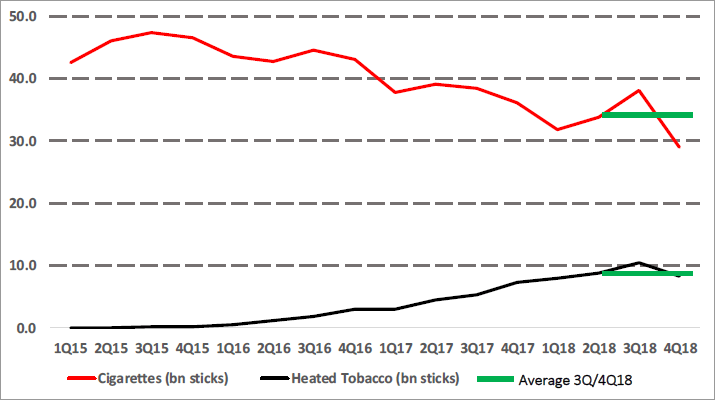Last week, Japan Tobacco Inc. reported full-year operating results for 2018. The data show that domestic cigarette industry volume is dropping at an unprecedented rate – more than 12% in 2018 and nearly 24% over the last two years. What is happening?
Heated tobacco product sales are driving double-digit annual percentage declines in Japanese domestic cigarette volume (Chart 1). Quarterly shipment volumes are volatile, but the trend is clear. The rate of change is unprecedented.

Source: Chart is based on data from company reports. Japan Tobacco Inc. reports monthly domestic cigarette sales volume and market share. Japan Tobacco Inc., Philip Morris International& British American Tobacco report heated tobacco volume and share data. Volumes are on an in-market shipment basis.
We believe the volume data demonstrate primarily a substitutive effect. The combustible cigarette stick volume declines are for the most part offset by heated tobacco stick volume increases. Based on the three above mentioned company reports, total sticks (cigarettes and heated tobacco) were approximately 183B in 2015, 180B in 2016, 171B in 2017, and 168B in 2018. Short-term volatility can mask the underlying trend. For example, cigarette shipment volume grew more than 20% year-over-year in September 2018 due to trade inventory loading in advance of an October tax increase, before unwinding in the fourth quarter. The averages for the third and fourth quarters (demonstrated by the green lines in Chart 1) are indicative of relative stability in cigarette and heated tobacco volumes over the period.
Could a 24% decline in cigarette smoking be achieved through traditional tobacco control measures?
Let’s start with pricing. Common wisdom states that the price elasticity of demand is approximately –0.4 on average, with about half attributable to prevalence (i.e., quitting) and half attributable to reduced consumption. Theoretically, an approximately 60% real price increase could drive the same 24% decrease on average in cigarette demand as has been experienced in Japan over the past two years.
Assuming an average 56.2% tax rate globally, an approximately 107% tax increase would be required to achieve an overall 60% price increase, all else held constant. Realistically, a greater than 100% tobacco tax increase is not politically feasible in most countries.
Unfortunately, no other interventions come close. According to the World Health Organization (WHO), “increasing the price of tobacco through higher taxes is the single most effective way to encourage tobacco users to quit.” Furthermore, the implementation of many tobacco control measures remains inconsistent. As the WHO Report on the Global Tobacco Epidemic 2017 indicates, “nearly two thirds of countries (121 of 194) – comprising 63% of the world’s population – have introduced at least one MPOWER measure at the highest level of achievement.” Only one country has implemented all policies at the highest level, and 73 have implemented none.
The path toward ending smoking in this generation – and eliminating combustible cigarettes – represents an arduous journey ahead. We estimate that the tobacco industry has combined revenues of nearly $800 billion dollars per year. It sells more than five trillion cigarettes annually, excluding illicit trade and locally manufactured combustible tobacco products, such as bidis in India. It delivers about $400 billion dollars in tax revenue to governments. More than ten million farmers, along with millions of factory workers, distributors, and retailers are involved in the supply chain. The global tobacco industry and nicotine ecosystem are massive.
The Foundation believes that innovation and consumer-driven demand are part of the solution, in addition to policy prescriptions. The record shows that implementation of policy strategies alone are not achieving the degree and speed in the reduction of cigarette smoking that is being witnessed in Japan. The Foundation believes now is time to bring all forces to bear toward achieving a smoke-free world.
© 2023 Foundation for a Smoke-Free World. All rights reserved.